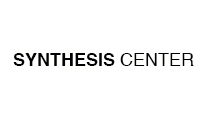Synthesis Center
The Synthesis Mission
The Synthesis Center at Arizona State University asks: How can we create environments that are richer, but not more complicated, and how can we create environments in which we would want to live?
How: Building an ecology of practices for re-imagining and re-making the spaces we inhabit
Synthesis Center researchers draw from diverse disciplines in the humanities, engineering and the arts to blend knowledge and know-how to find meaningful ways of using the arts and technology to animate the worlds in which we live and play. In particular, we use techniques from responsive environments, time-based media, phenomenology, non-anthropocentric design and theory.
Rather than throwing disciplines together, we give our collaborators time to respect and meld distinct, even incommensurate values and ways of thinking and making into an ecology of practices.
Gray Center for Arts and Inquiry, the University of Chicago
A mutual love of the arts drew Richard and Mary Gray together when they met almost 60 years ago and has been a driving passion in their lives ever since.
‘The search for knowledge about and experience with the arts are critical to the development of humanistic values,’ says Richard Gray, a lifelong Chicagoan, internationally distinguished art dealer, noted private collector, and architectural landmark preservationist. The Richard Gray Gallery of Chicago and New York specializes in painting, sculpture, and drawings by 20th-century American and European artists. Mary Gray, AM’78, is a published author who has written two books on Chicago’s public sculpture and murals.
‘No one represents the arts better in this city than Richard and Mary Gray,’ says Larry Norman, Deputy Provost for the Arts.
Technoculture, Art and Games
Technoculture, Art and Games
Technoculture, Art and Games (TAG) is an interdisciplinary centre for research/creation in game studies and design, digital culture and interactive art based at Concordia University in Montréal. TAG brings together scholars, artists, designers, engineers and students from all departments at Concordia and we welcome participants from other universities, the game and media arts industries and community based groups. See our members page.
At the heart of TAG is a shared interest and concern with digital games as exemplary objects for cultural research, artistic creation, technical innovation and social mediation, all in the context of an expanding information society and the changing fabric of everyday life.
TAG has a triple mandate to:
- » Initiate and support collaborative research/creation of projects in digital game studies and design, both at the student and faculty levels.
- » Build bridges and establish partnerships with games related industries, independent game developers and international researchers and artists.
- » Actively explore and develop viable models of interdisciplinary research collaboration.
Sense Lab
The Sense Lab is a laboratory for thought in motion
The Sense Lab is composed of artists, academics, researchers, dancers, writers. We work together to explore the active passage between research and creation. We consider research to be creation in germ, and creation to produce its own concepts for thought.
Erin Manning founded the Sense Lab in 2004 in an effort to conceive a working and thinking environment for the creation of new modes of encounter. Since then, we’ve held monthly reading groups as well as a bi-monthly speaker-series entitled Bodies-Bits///Corps-Données which is a platform for the exploration of work in progress both local and international.
We host a series of international events under the rubric Technologies of Lived Abstraction. This event series was conceived as a vehicle for the exploration of modes of participation that take thought as their laboratory for creative practice and creative practice as a platform for thought. Our first event, Dancing the Virtual (2005), focused on the movements of thought through the prism of relational movement and philosophy. Housing the Body, Dressing the Environment (2007) was composed around platforms for relation that activated the constellation architecture-body-environment-thought. Society of Molecules (2009) invites participants to plan local micropolitical “molecules” engaging in aesthetico-political interventions in a distributive participatory model.
Since 2008, we have started hosting residencies. We welcome approaches to research-creation that seek to open thought.
Our online multi-media journal is entitled Inflexions: A Journal for Research-Creation.
Everyone is welcome. We are located at Concordia University (Hexagram) in EV 11-625, 11-655.
Synthesis Center
The Synthesis Mission
The Synthesis Center at Arizona State University asks: How can we create environments that are richer, but not more complicated, and how can we create environments in which we would want to live?
How: Building an ecology of practices for re-imagining and re-making the spaces we inhabit
Synthesis Center researchers draw from diverse disciplines in the humanities, engineering and the arts to blend knowledge and know-how to find meaningful ways of using the arts and technology to animate the worlds in which we live and play. In particular, we use techniques from responsive environments, time-based media, phenomenology, non-anthropocentric design and theory.
Rather than throwing disciplines together, we give our collaborators time to respect and meld distinct, even incommensurate values and ways of thinking and making into an ecology of practices.
Gray Center for Arts and Inquiry, the University of Chicago
A mutual love of the arts drew Richard and Mary Gray together when they met almost 60 years ago and has been a driving passion in their lives ever since.
‘The search for knowledge about and experience with the arts are critical to the development of humanistic values,’ says Richard Gray, a lifelong Chicagoan, internationally distinguished art dealer, noted private collector, and architectural landmark preservationist. The Richard Gray Gallery of Chicago and New York specializes in painting, sculpture, and drawings by 20th-century American and European artists. Mary Gray, AM’78, is a published author who has written two books on Chicago’s public sculpture and murals.
‘No one represents the arts better in this city than Richard and Mary Gray,’ says Larry Norman, Deputy Provost for the Arts.
Technoculture, Art and Games
Technoculture, Art and Games
Technoculture, Art and Games (TAG) is an interdisciplinary centre for research/creation in game studies and design, digital culture and interactive art based at Concordia University in Montréal. TAG brings together scholars, artists, designers, engineers and students from all departments at Concordia and we welcome participants from other universities, the game and media arts industries and community based groups. See our members page.
At the heart of TAG is a shared interest and concern with digital games as exemplary objects for cultural research, artistic creation, technical innovation and social mediation, all in the context of an expanding information society and the changing fabric of everyday life.
TAG has a triple mandate to:
- » Initiate and support collaborative research/creation of projects in digital game studies and design, both at the student and faculty levels.
- » Build bridges and establish partnerships with games related industries, independent game developers and international researchers and artists.
- » Actively explore and develop viable models of interdisciplinary research collaboration.
Sense Lab
The Sense Lab is a laboratory for thought in motion
The Sense Lab is composed of artists, academics, researchers, dancers, writers. We work together to explore the active passage between research and creation. We consider research to be creation in germ, and creation to produce its own concepts for thought.
Erin Manning founded the Sense Lab in 2004 in an effort to conceive a working and thinking environment for the creation of new modes of encounter. Since then, we’ve held monthly reading groups as well as a bi-monthly speaker-series entitled Bodies-Bits///Corps-Données which is a platform for the exploration of work in progress both local and international.
We host a series of international events under the rubric Technologies of Lived Abstraction. This event series was conceived as a vehicle for the exploration of modes of participation that take thought as their laboratory for creative practice and creative practice as a platform for thought. Our first event, Dancing the Virtual (2005), focused on the movements of thought through the prism of relational movement and philosophy. Housing the Body, Dressing the Environment (2007) was composed around platforms for relation that activated the constellation architecture-body-environment-thought. Society of Molecules (2009) invites participants to plan local micropolitical “molecules” engaging in aesthetico-political interventions in a distributive participatory model.
Since 2008, we have started hosting residencies. We welcome approaches to research-creation that seek to open thought.
Our online multi-media journal is entitled Inflexions: A Journal for Research-Creation.
Everyone is welcome. We are located at Concordia University (Hexagram) in EV 11-625, 11-655.
David O’Brien Centre for Sustainable Enterprise
Named after benefactor David O’Brien, Chairman of RBC and Encana, the David O’Brien Centre for Sustainable Enterprise was inaugurated in November 2009. Paul Shrivastava, the Centre’s director, spearheads the Centre’s efforts to be the leader in developing business practices that support corporate social responsibility, environmental health and safety, environmental management, community, and greening activities.
The David O’Brien Centre for Sustainable Enterprise (DOCSE) focuses its efforts on guiding organizations toward holistic sustainable strategies that are rooted in innovation and enterprise development.
The Centre is committed to:
- advancing scholarly research endeavors
- creating world-class teaching and learning opportunities
- developing community outreach initiatives
District3 Vision
Our mission is to create an ecosystem for bridging the gap between academia, industry and government, and to leverage the underlying potential available to materialize radical innovations.
The common misconception of innovation is to often confuse it with invention and to believe that it’s the creation of a new product. The sole definition of innovation is the creation of those better or more effective products, processes, services, technologies or ideas that are accepted by markets, governments, and society.
The value of Innovation comes from the creation of new products and services. Experts agree that the innovation process generates economic growth and a sustained competitiveness; it creates value out of knowledge and/or out of inventions from research. But it is a complex process requiring the alignment and drive of the many different actors and stakeholders of the ecosystem it is to bring benefits to.
[youtube]http://www.youtube.com/watch?v=IW0JKrWLNJ8&feature=youtu.be[/youtube]
The Dream & Nightmare Laboratory
The Dream & Nightmare Laboratory, established in Montreal’s Sacré-Coeur (Sacred Heart) Hospital in 1991, is dedicated to the scientific study of dreaming and its disorders, to the training of graduate students, researchers and health professionals in the techniques and applications of dream science, to the development and deployment of proven methods for treating dream-related health problems, and to public education about the important role dreams and nightmares play in psychological life.
the Cognitive Sciences Institute of UQAM
Founded in 2003, the Cognitive Sciences Institute of UQAM constitutes a multifaculty unit under the faculties of Social sciences and of Sciences; it is also multidepartmental. It is intended to promote research and skills development in the field of cognitive sciences. The CSI is made up of researchers whose areas of expertise cover practically the entire field. It acts as a point of convergence for the activities of existing research teams and is also open to their external partners.
Four research clusters have been defined that create links between, and structure, the members’ research programs. Coordinating activities in dynamic clusters also favors the recruitment of students and ensures that they receive an integrated education in cognitive sciences.
Synthesis Center
The Synthesis Mission
The Synthesis Center at Arizona State University asks: How can we create environments that are richer, but not more complicated, and how can we create environments in which we would want to live?
How: Building an ecology of practices for re-imagining and re-making the spaces we inhabit
Synthesis Center researchers draw from diverse disciplines in the humanities, engineering and the arts to blend knowledge and know-how to find meaningful ways of using the arts and technology to animate the worlds in which we live and play. In particular, we use techniques from responsive environments, time-based media, phenomenology, non-anthropocentric design and theory.
Rather than throwing disciplines together, we give our collaborators time to respect and meld distinct, even incommensurate values and ways of thinking and making into an ecology of practices.
Gray Center for Arts and Inquiry, the University of Chicago
A mutual love of the arts drew Richard and Mary Gray together when they met almost 60 years ago and has been a driving passion in their lives ever since.
‘The search for knowledge about and experience with the arts are critical to the development of humanistic values,’ says Richard Gray, a lifelong Chicagoan, internationally distinguished art dealer, noted private collector, and architectural landmark preservationist. The Richard Gray Gallery of Chicago and New York specializes in painting, sculpture, and drawings by 20th-century American and European artists. Mary Gray, AM’78, is a published author who has written two books on Chicago’s public sculpture and murals.
‘No one represents the arts better in this city than Richard and Mary Gray,’ says Larry Norman, Deputy Provost for the Arts.
Technoculture, Art and Games
Technoculture, Art and Games
Technoculture, Art and Games (TAG) is an interdisciplinary centre for research/creation in game studies and design, digital culture and interactive art based at Concordia University in Montréal. TAG brings together scholars, artists, designers, engineers and students from all departments at Concordia and we welcome participants from other universities, the game and media arts industries and community based groups. See our members page.
At the heart of TAG is a shared interest and concern with digital games as exemplary objects for cultural research, artistic creation, technical innovation and social mediation, all in the context of an expanding information society and the changing fabric of everyday life.
TAG has a triple mandate to:
- » Initiate and support collaborative research/creation of projects in digital game studies and design, both at the student and faculty levels.
- » Build bridges and establish partnerships with games related industries, independent game developers and international researchers and artists.
- » Actively explore and develop viable models of interdisciplinary research collaboration.
Sense Lab
The Sense Lab is a laboratory for thought in motion
The Sense Lab is composed of artists, academics, researchers, dancers, writers. We work together to explore the active passage between research and creation. We consider research to be creation in germ, and creation to produce its own concepts for thought.
Erin Manning founded the Sense Lab in 2004 in an effort to conceive a working and thinking environment for the creation of new modes of encounter. Since then, we’ve held monthly reading groups as well as a bi-monthly speaker-series entitled Bodies-Bits///Corps-Données which is a platform for the exploration of work in progress both local and international.
We host a series of international events under the rubric Technologies of Lived Abstraction. This event series was conceived as a vehicle for the exploration of modes of participation that take thought as their laboratory for creative practice and creative practice as a platform for thought. Our first event, Dancing the Virtual (2005), focused on the movements of thought through the prism of relational movement and philosophy. Housing the Body, Dressing the Environment (2007) was composed around platforms for relation that activated the constellation architecture-body-environment-thought. Society of Molecules (2009) invites participants to plan local micropolitical “molecules” engaging in aesthetico-political interventions in a distributive participatory model.
Since 2008, we have started hosting residencies. We welcome approaches to research-creation that seek to open thought.
Our online multi-media journal is entitled Inflexions: A Journal for Research-Creation.
Everyone is welcome. We are located at Concordia University (Hexagram) in EV 11-625, 11-655.
David O’Brien Centre for Sustainable Enterprise
Named after benefactor David O’Brien, Chairman of RBC and Encana, the David O’Brien Centre for Sustainable Enterprise was inaugurated in November 2009. Paul Shrivastava, the Centre’s director, spearheads the Centre’s efforts to be the leader in developing business practices that support corporate social responsibility, environmental health and safety, environmental management, community, and greening activities.
The David O’Brien Centre for Sustainable Enterprise (DOCSE) focuses its efforts on guiding organizations toward holistic sustainable strategies that are rooted in innovation and enterprise development.
The Centre is committed to:
- advancing scholarly research endeavors
- creating world-class teaching and learning opportunities
- developing community outreach initiatives
District3 Vision
Our mission is to create an ecosystem for bridging the gap between academia, industry and government, and to leverage the underlying potential available to materialize radical innovations.
The common misconception of innovation is to often confuse it with invention and to believe that it’s the creation of a new product. The sole definition of innovation is the creation of those better or more effective products, processes, services, technologies or ideas that are accepted by markets, governments, and society.
The value of Innovation comes from the creation of new products and services. Experts agree that the innovation process generates economic growth and a sustained competitiveness; it creates value out of knowledge and/or out of inventions from research. But it is a complex process requiring the alignment and drive of the many different actors and stakeholders of the ecosystem it is to bring benefits to.
[youtube]http://www.youtube.com/watch?v=IW0JKrWLNJ8&feature=youtu.be[/youtube]
The Dream & Nightmare Laboratory
The Dream & Nightmare Laboratory, established in Montreal’s Sacré-Coeur (Sacred Heart) Hospital in 1991, is dedicated to the scientific study of dreaming and its disorders, to the training of graduate students, researchers and health professionals in the techniques and applications of dream science, to the development and deployment of proven methods for treating dream-related health problems, and to public education about the important role dreams and nightmares play in psychological life.
the Cognitive Sciences Institute of UQAM
Founded in 2003, the Cognitive Sciences Institute of UQAM constitutes a multifaculty unit under the faculties of Social sciences and of Sciences; it is also multidepartmental. It is intended to promote research and skills development in the field of cognitive sciences. The CSI is made up of researchers whose areas of expertise cover practically the entire field. It acts as a point of convergence for the activities of existing research teams and is also open to their external partners.
Four research clusters have been defined that create links between, and structure, the members’ research programs. Coordinating activities in dynamic clusters also favors the recruitment of students and ensures that they receive an integrated education in cognitive sciences.
CIRMMT
CIRMMT is a multi-disciplinary research group centred at the Schulich School of Music of McGill University. It unites researchers and their students from three Quebec institutions – McGill University (Faculties of Music, Science, Engineering, Education and Medicine), l’Université de Montréal (Faculté de musique, Faculté des arts & des sciences), and l’Université de Sherbrooke (Faculté de génie). The CIRMMT community also includes administrative and technical staff, research associates, visiting scholars, musicians, and industrial associates. CIRMMT occupies a unique position on the international stage having developed intense research partnerships with other academic and research institutions, as well as diverse industry partners throughout the world.
The CIRMMT community is interested in interdisciplinary research related to the creation of music in the composer’s or performer’s mind, the performance of music, its recording and/or transmission, and the reception of music by the listener. It is also interested in the ways in which vision, haptics and touch interact with music and sound. CIRMMT seeks to develop innovative approaches to the scientific study of music media and technology, to promote the application of newer technologies in science and the creative arts, and to provide an advanced research training environment.










